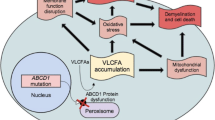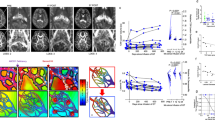Abstract
Background
Childhood cerebral adrenoleukodystrophy (CCALD), a progressive demyelinating disease affecting school-aged boys, causes death within a few years. Oxidative stress is an important contributing factor. N-acetylcysteine (NAC; 280 mg/kg/day) added as adjunctive therapy to reduced-intensity hematopoietic cell transplantation (HCT) improves survival in advanced cases. However, the mechanisms underlying the benefits of NAC are unclear.
Objective
The aim of this study was to understand the mechanism of action of NAC in the setting of HCT in CCALD.
Methods
Immunoassays were carried out to determine changes in heme oxygenase-1 (HO-1) and ferritin expression in plasma samples collected from boys with CCALD at three different timepoints during the course of transplantation. In addition, the induction of HO-1 was also confirmed in normal fibroblasts following incubation with 10–100 µmol/L NAC for 4 h.
Results
Following NAC therapy we observed an increase in expression of the antioxidants HO-1 (~4-fold) and its effector ferritin (~160-fold) in patient samples as compared with baseline. We also observed that NAC exposure significantly increased HO-1 expression in fibroblasts.
Conclusion
Our data suggest that HO-1 is a possible target protein of NAC and a mediator of its cytoprotective effects in these patients.



Similar content being viewed by others
References
Santosh Rai PV, Suresh BV, Bhat IG, Sekhar M, Chakraborti S. Childhood adrenoleukodystrophy—classic and variant—review of clinical manifestations and magnetic resonance imaging. J Pediatr Neurosci. 2013;8(3):192–7. doi:10.4103/1817-1745.123661.
Vargas CR, Wajner M, Sirtori LR, Goulart L, Chiochetta M, Coelho D, et al. Evidence that oxidative stress is increased in patients with X-linked adrenoleukodystrophy. Biochim Biophys Acta. 2004;1688(1):26–32. doi:10.1016/j.bbadis.2003.10.004.
Powers JM, Pei Z, Heinzer AK, Deering R, Moser AB, Moser HW, et al. Adreno-leukodystrophy: oxidative stress of mice and men. J Neuropathol Exp Neurol. 2005;64(12):1067–79. doi:10.1097/01.jnen.0000190064.28559.a4.
Deon M, Marchetti DP, Donida B, Wajner M, Vargas C. Oxidative stress in patients with X-linked adrenoleukodystrophy. Cell Mol Neurobiol. 2015. doi:10.1007/s10571-015-0234-2 (Epub 2015 Jul 14).
Petrillo S, Piemonte F, Pastore A, Tozzi G, Aiello C, Pujol A, et al. Glutathione imbalance in patients with X-linked adrenoleukodystrophy. Mol Genet Metab. 2013;109(4):366–70. doi:10.1016/j.ymgme.2013.05.009.
Lopez-Erauskin J, Galino J, Bianchi P, Fourcade S, Andreu AL, Ferrer I, et al. Oxidative stress modulates mitochondrial failure and cyclophilin D function in X-linked adrenoleukodystrophy. Brain. 2012;135(Pt 12):3584–98. doi:10.1093/brain/aws292.
Igarashi M, Schaumburg HH, Powers J, Kishmoto Y, Kolodny E, Suzuki K. Fatty acid abnormality in adrenoleukodystrophy. J Neurochem. 1976;26(4):851–60.
Kapelushnik J, Varadi G, Nagler A. Matched unrelated human umbilical cord blood transplantation for X-linked adrenoleukodystrophy. J Pediatr Hematol Oncol. 1998;20(3):257–9.
Suzuki Y, Isogai K, Teramoto T, Tashita H, Shimozawa N, Nishimura M, et al. Bone marrow transplantation for the treatment of X-linked adrenoleukodystrophy. J Inherit Metab Dis. 2000;23(5):453–8.
Resnick IB, Abdul Hai A, Shapira MY, Bitan M, Hershkovitz E, Schwartz A, et al. Treatment of X-linked childhood cerebral adrenoleukodystrophy by the use of an allogeneic stem cell transplantation with reduced intensity conditioning regimen. Clin Transplant. 2005;19(6):840–7. doi:10.1111/j.1399-0012.2005.00411.x.
Ringden O, Remberger M, Svahn BM, Barkholt L, Mattsson J, Aschan J, et al. Allogeneic hematopoietic stem cell transplantation for inherited disorders: experience in a single center. Transplantation. 2006;81(5):718–25. doi:10.1097/01.tp.0000181457.43146.36.
Beam D, Poe MD, Provenzale JM, Szabolcs P, Martin PL, Prasad V, et al. Outcomes of unrelated umbilical cord blood transplantation for X-linked adrenoleukodystrophy. Biol Blood Marrow Transplant. 2007;13(6):665–74. doi:10.1016/j.bbmt.2007.01.082.
Miller WP, Rothman SM, Nascene D, Kivisto T, DeFor TE, Ziegler RS, et al. Outcomes after allogeneic hematopoietic cell transplantation for childhood cerebral adrenoleukodystrophy: the largest single-institution cohort report. Blood. 2011;118(7):1971–8. doi:10.1182/blood-2011-01-329235.
Tolar J, Orchard PJ, Bjoraker KJ, Ziegler RS, Shapiro EG, Charnas L. N-Acetyl-l-cysteine improves outcome of advanced cerebral adrenoleukodystrophy. Bone Marrow Transplant. 2007;39(4):211–5. doi:10.1038/sj.bmt.1705571.
Zafarullah M, Li WQ, Sylvester J, Ahmad M. Molecular mechanisms of N-acetylcysteine actions. Cell Mol Life Sci. 2003;60(1):6–20.
Marchetti DP, Donida B, da Rosa HT, Manini PR, Moura DJ, Saffi J, et al. Protective effect of antioxidants on DNA damage in leukocytes from X-linked adrenoleukodystrophy patients. Int J Dev Neurosci. 2015;43:8–15. doi:10.1016/j.ijdevneu.2015.03.004.
Galino J, Ruiz M, Fourcade S, Schluter A, Lopez-Erauskin J, Guilera C, et al. Oxidative damage compromises energy metabolism in the axonal degeneration mouse model of X-adrenoleukodystrophy. Antioxid Redox Signal. 2011;15(8):2095–107. doi:10.1089/ars.2010.3877.
Lopez-Erauskin J, Fourcade S, Galino J, Ruiz M, Schluter A, Naudi A, et al. Antioxidants halt axonal degeneration in a mouse model of X-adrenoleukodystrophy. Ann Neurol. 2011;70(1):84–92. doi:10.1002/ana.22363.
Fourcade S, Lopez-Erauskin J, Galino J, Duval C, Naudi A, Jove M, et al. Early oxidative damage underlying neurodegeneration in X-adrenoleukodystrophy. Hum Mol Genet. 2008;17(12):1762–73. doi:10.1093/hmg/ddn085.
Masonic Cancer Center, University of Minnesota. Treatment of high risk, inherited lysosomal and peroxisomal disorders by reduced intensity hematopoietic stem cell transplantation [ClinicalTrials.gov identifier NCT00383448]. US National Institutes of Health, ClinicalTrials.gov. https://www.clinicaltrials.gov. Accessed 25 Nov 2015.
Bao W, Rong S, Zhang M, Yu X, Zhao Y, Xiao X, et al. Plasma heme oxygenase-1 concentration in relation to impaired glucose regulation in a non-diabetic Chinese population. PLoS One. 2012;7(3):e32223. doi:10.1371/journal.pone.0032223.
Billings IF, Yu C, Byrne JG, Petracek MR, Pretorius M. Heme oxygenase-1 and acute kidney injury following cardiac surgery. Cardiorenal Med. 2014;4(1):12–21. doi:10.1159/000357871.
Mateo I, Infante J, Sanchez-Juan P, Garcia-Gorostiaga I, Rodriguez-Rodriguez E, Vazquez-Higuera JL, et al. Serum heme oxygenase-1 levels are increased in Parkinson’s disease but not in Alzheimer’s disease. Acta Neurol Scand. 2010;121(2):136–8. doi:10.1111/j.1600-0404.2009.01261.x.
Bharucha AE, Kulkarni A, Choi KM, Camilleri M, Lempke M, Brunn GJ, et al. First-in-human study demonstrating pharmacological activation of heme oxygenase-1 in humans. Clin Pharmacol Ther. 2010;87(2):187–90. doi:10.1038/clpt.2009.221.
Atkuri KR, Mantovani JJ, Herzenberg LA. N-Acetylcysteine—a safe antidote for cysteine/glutathione deficiency. Curr Opin Pharmacol. 2007;7(4):355–9. doi:10.1016/j.coph.2007.04.005.
Zhou J, Coles LD, Kartha RV, Nash N, Mishra U, Lund TC, et al. Intravenous administration of stable-labeled N-acetylcysteine demonstrates an indirect mechanism for boosting glutathione and improving redox status. J Pharm Sci. 2015;104(8):2619–26. doi:10.1002/jps.24482.
Radtke KK, Coles LD, Mishra U, Orchard PJ, Holmay M, Cloyd JC. Interaction of N-acetylcysteine and cysteine in human plasma. J Pharm Sci. 2012;101(12):4653–9. doi:10.1002/jps.23325.
Ewing P, Hildebrandt GC, Planke S, Andreesen R, Holler E, Gerbitz A. Cobalt protoporphyrine IX-mediated heme oxygenase-I induction alters the inflammatory cytokine response, but not antigen presentation after experimental allogeneic bone marrow transplantation. Int J Mol Med. 2007;20(3):301–8.
Gerbitz A, Ewing P, Wilke A, Schubert T, Eissner G, Dietl B, et al. Induction of heme oxygenase-1 before conditioning results in improved survival and reduced graft-versus-host disease after experimental allogeneic bone marrow transplantation. Biol Blood Marrow Transplant. 2004;10(7):461–72. doi:10.1016/j.bbmt.2004.04.001.
Bach FH. Heme oxygenase-1 and transplantation tolerance. Hum Immunol. 2006;67(6):430–2. doi:10.1016/j.humimm.2006.03.006.
Rockenbach FJ, Deon M, Marchese DP, Manfredini V, Mescka C, Ribas GS, et al. The effect of bone marrow transplantation on oxidative stress in X-linked adrenoleukodystrophy. Mol Genet Metab. 2012;106(2):231–6. doi:10.1016/j.ymgme.2012.03.019.
Schipper HM, Gupta A, Szarek WA. Suppression of glial HO-1 activity as a potential neurotherapeutic intervention in AD. Curr Alzheimer Res. 2009;6(5):424–30. doi:10.2174/156720509789207985.
Or R, Matzner Y, Konijn AM. Serum ferritin in patients undergoing bone marrow transplantation. Cancer. 1987;60(5):1127–31.
Author contributions
Designed the experiments: RVK, JZ, LB, HS, PJO, JC. Performed the experiments: JZ, RVK, LB. Analyzed the data: JZ, RVK, LB, HS. Contributed essential reagents/tools: PJO, JC, HS. Wrote the paper: RVK, JZ, LB, HS, PJO, JC.
Author information
Authors and Affiliations
Corresponding author
Ethics declarations
Funding
The study was funded by a University of Minnesota Academic Health Center Faculty Development Grant to JC and PJO.
Conflict of interest
RVK, JZ, LB, HS, PJO, and JC declare that they have no conflicts of interest.
Ethical approval
All procedures performed in studies involving human participants were in accordance with the ethical standards of the institutional and/or national research committee and with the 1964 Helsinki declaration and its later amendments or comparable ethical standards.
Additional information
R. V. Kartha and J. Zhou contributed equally to this work.
Electronic supplementary material
Below is the link to the electronic supplementary material.
Rights and permissions
About this article
Cite this article
Kartha, R.V., Zhou, J., Basso, L. et al. Mechanisms of Antioxidant Induction with High-Dose N-Acetylcysteine in Childhood Cerebral Adrenoleukodystrophy. CNS Drugs 29, 1041–1047 (2015). https://doi.org/10.1007/s40263-015-0300-9
Published:
Issue Date:
DOI: https://doi.org/10.1007/s40263-015-0300-9




